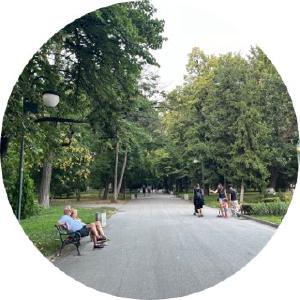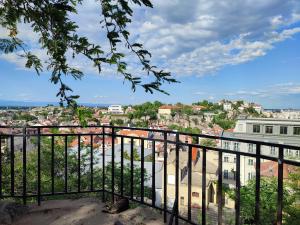About the Project
Scope of the group’s research programme
The built, natural and social environments in human settlements have a profound impact on the health of populations, as illustrated by the saying “genetics loads the gun, but the environment pulls the trigger”. There is evidence that various features of the living environment, such as exposure to traffic emissions and green space, access to services, availability of different land uses and amenities shape human behavior and health.

Furthermore, modifications to the living environment extend beyond the individual and have the potential to benefit large population groups. Therefore, recent years have seen an increase in research on urban planning decisions and policies based on evidence of health effects. Health impact assessment studies are a powerful tool to guide the transition of cities towards healthier, more liveable and sustainable (e.g., carbon neutral) habitats for people through better land use changes and better transport planning.
However, these efforts remain isolated and cannot be directly transferred to other contexts, such as Bulgarian cities, which have a particular fabric, municipalities are underfunded, and urban development is not guided by the projected health impacts of alternative development scenarios. Traditional interventions in the country are not sufficiently transdisciplinary and therefore fail to link the environment and public health sectors. Citizens are seen as the target of such interventions rather than as actors in the decision-making process.

Progress in this area in Bulgaria is further limited by the lack of large-scale population-based studies of the joint effects of the built and natural environments on quality of life and the prevalence of non-communicable diseases. Changes in urban form have the potential to reduce the burden of environmental pollution, which is not only a product of emission sources but is also modified by urban infrastructure, e.g. through enhanced dispersion and spatial distribution of pollutants. Although we see evidence of the health impacts of urban living, acquiring additional information is methodologically challenging. Therefore, these research deficits provide an opportunity to leverage modern technologies in environmental research.
In this context, it is clear that local evidence on the exposure-effect relationships between these factors and health outcomes is urgently needed to inform recommendations and practice-oriented urban design tools that will inform the optimal parameters of residential neighborhoods to reduce disease burden and support quality of life.
Research objectives
This project has a dual purpose. First, to use data and experience from international sources to expand our understanding of the health impacts of established environmental determinants of health that are largely neglected in Bulgaria. Second, to go beyond what is already known by using modern exposure assessment techniques and applying them to a comprehensive health survey conducted in Bulgaria, specifically to inform urban planning and encourage public engagement in the process.
Methods
Systematic and narrative literature reviews on the evidence for healthy urban planning in Bulgaria and abroad.
Secondary epidemiological analyses of existing epidemiological datasets in different population groups in the country and worldwide.
A specially designed epidemiological study in five cities that will provide input on specific exposure indicators of locality characteristics associated with practically important health impacts. We objectively collect exposure data in residential, work/school and leisure time environments on green space /quantity/quality/, air and noise pollution from various sources, light pollution at night, socio-economic status of the neighbourhood, pedestrian infrastructure, etc. We also collect data on lifestyle, health status, medical history, self-reported diagnosed chronic diseases and medication use. Data is also collected on socio-demographic and contextual modifiers (e.g., age, gender, ethnicity, socio-economic status, population density).
Development of GIS scripts and spatial data collection for built and natural factors.
Development of an interactive online Geographic Information System (GIS) platform to inform healthy urban planning in Bulgarian cities, including GIS exposure layers that we develop for the study and that could be used in future research, interactive maps presenting expected health impacts of existing urban exposure/infrastructure, a guidance package and recommendations for alternative urban development scenarios based on scientific evidence on health.
Expected results
We will create a set of specific recommendations for healthy, liveable cities based on examining evidence from existing environmental studies and establishing their relevance to Bulgarian cities, as well as local exposure-effect relationships that will be derived from a specific population-based study. These will provide risk coefficients that could be used to calculate disease burden and projected changes in health effects under different exposure scenarios.
Evidence from existing urban governance, management, planning and design solutions, as well as new evidence from Bulgarian research within this research line, will be made available through a searchable online platform with different layers of spatial data on exposures and health effects that could be used by practitioners and researchers. Evidence of health effects of environmental factors will be further mapped, showing hotspots in the study area, with groupings of harmful and salutogenic urban features (e.g., land use, morphology, activities) and associated health effects. A set of recommendations and feasible solutions for urban development aimed at mitigating harmful and promoting salutogenic exposures will be developed and transformed into a geospatially referenced, searchable catalogue that will enable information exchange between stakeholders, citizens and academia. This living toolkit will be updated as new evidence on sustainable solutions and health impacts becomes available, and will dynamically reflect stakeholder feedback.
Research activities for the period 2023-2024 and milestones
In parallel to the planning and implementation of an epidemiological study in Bulgaria, the group’s researchers, in collaboration with international teams, has conducted a number of systematic and narrative reviews and meta-analyses on the impact of the urban environment on mental health and well-being.
We developed conceptual causal models of the relationships between urban environmental factors and various health indicators investigated in the epidemiological study. These models take into account the pathways/mechanisms by which these effects are likely to occur, as well as possible effect modifiers.
A population-based, nationally-representative sociological survey has been completed in the cities of Sofia, Plovdiv, Varna, Burgas and Ruse among 4640 adults, representative of the population of the five selected cities. The study design has received a positive statement by the Scientific Ethics Committee (Protocol No. 4/04.05.2023) of the MU-Plovdiv.
The urban environment was characterized by spatially resolved data/maps generated on the exposure to different factors. Geographical layers with indicators of greenness, light pollution and built-up area, corresponding maps and meta-data for the five cities included in the study were generated. A walkability indicator was created, as well as indicators for the food environment.
In the second half of 2023, a campaign for monthly measurements of nitrogen dioxide (NO2) in the city of Plovdiv was conducted for a 6-month period. The results served as input data for the development of a land use regression model to calculate nitrogen dioxide for all addresses in our study in the city of Plovdiv.
In 2025 and 2026, an extended measurement campaign for NO2 and traffic noise with traffic counting is underway in the five cities, based on which more accurate models for population exposure will be developed.
From the Regional Health Inspectorates in Sofia, Plovdiv, Varna, Burgas and Ruse, data on measured noise levels and traffic counts over the last 5 years were obtained, which were used by the group to create a land use regression model to calculate road noise for the territory of the five cities, using machine learning through an iterative stepwise approach and an extreme gradient boosting model. Based on the results of this model, a raster map of noise levels was created.
Combining the data from the generated geospatial layers of exposure to different environmental characteristics and the data from the epidemiological/sociological survey, analyses of the relationship between different characteristics of the urban environment and health indicators have been carried out - dose-effect relationships between exposure to noise from different traffic types and high noise annoyance in the population; estimation of the socio-economic burden of traffic noise annoyance in the five cities; relationship between greenness in the residential environment and feelings of loneliness; relationship between light pollution, green space, blue space, traffic noise, air pollution and walkability with health, mainly cardiometabolic diseases; nighttime light pollution and sleep quality and mental health; inequalities in exposure to nighttime light pollution; association between nature exposure and loneliness.
A web-GIS information platform for the project is under development. A conceptual model for the structure and content of the platform is being developed - interactive and static or downloadable maps with modelled urban environment characteristics (e.g., air, noise and light pollution, greenery, walkability), a manual with guidelines and recommendations for healthy urban planning and development, a section for sharing scientific data and project results.
In the course of the project implementation, MU-Plovdiv started the implementation, as a partner, of a new project RESONATE “Building individual and community RESilience through NATurE-based therapies”, funded by Horizon Europe (Grant agreement ID: 101081420). The project complements and expands for the first time the profile of the MU-Plovdiv in Horizon Cluster 6 (Food, Bioeconomy, Natural Resources, Agriculture and Environment). The RESONATE project is interdisciplinary and brings together different perspectives on the two-sided benefits of human interaction with nature and the green environment, in terms of health, environmental protection, agriculture, forestry, education, etc.
A list of stakeholders with representatives of international, European, national and local organisations and institutions, professional and business organisations with details of their representatives and contacts has been prepared.
An expert opinion is presented in connection with the draft of the Ministry of Health for discussion of normative changes in the national legislation - Draft Ordinance on health requirements for the development of urban areas.
Memoranda have been concluded with professional and business organisations.
Scientific papers with results of the activities carried out under the work programme have been published. The results and work of the group were presented at a number of national and international scientific forums.